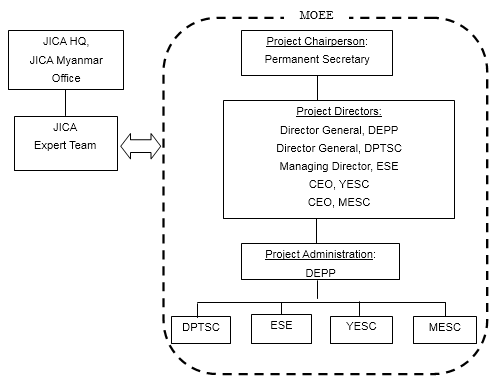Outline of the Project
Project Title
The Project for Capacity Development of Power Transmission and Distribution Systems
Country
The Republic of the Union of Myanmar
Project Site
Nay Pyi Taw as the main site and the whole country of Myanmar
Project period
20th July 2016 to 19th July 2021
Date of R/D signed
22nd January 2016
Counterpart Organization
- Implementing Agency: Ministry of Electricity and Energy (MOEE)
- Related Organizations under MOEE
- Department of Electric Power Planning (DEPP)
- Department of Power Transmission and System Control (DPTSC)
- Electricity Supply Enterprise (ESE)
- Yangon Electricity Supply Corporation (YESC)
- Mandalay Electricity Supply Corporation (MESC)
Background
Myanmar's power demand is forecasted to further increase with the annual growth rate of around or over 15% due to its growing economy as well as low level of electrification ratio at present. In 2010-2011, electricity had been supplied to 2.42 million households which are merely 27% of the whole country. While about 3.5 million households, 34% of the whole country, had accessed to electricity in this year 2015, Myanmar still needs to increase the power generation, transmission and distribution to fulfill the electricity supply to the rest of the people of 66%.
Peak load for power in Myanmar nationwide was around 1,588 MW in 2011 and increased to 2,370 MW in 2015. The power supply and demand balance throughout the country in dry season faces severe imbalance due to declining of generation capacity of hydro power plants, deterioration of aging facilities and shortage of fuel and it causes load shedding.
The power transmission and distribution losses in the whole Myanmar reach about 20%, with the transmission loss at 4.6% and the power distribution loss at 15.4%. Furthermore, since aging facilities have been used under overload conditions for long time, there are high risks of trouble occurrence including large-scale power outage. Short-circuit and grounding faults are also common and cause frequent interruption.
In this situation, the Government of Myanmar has put the importance of developing the electric power sector as one of its priority sector, and expressed its intention to promote electrification at full capacity in Yangon region and Mandalay region where most of the industries are being run and to raise the number of households in all regions and states that can use electricity. It is thus imperative to augment and upgrade power facilities in the respective subsectors of generation, transmission and distribution.
Ministry of Electricity and Energy (MOEE), however, has neither had a comprehensive system for the capacity development of its engineers and technicians for transmission and distribution, nor had systematic and regular training courses. While JICA's resident advisor had been assisting Yangon Electricity Supply Corporation (YESC) to develop their technical capacity and strengthen training courses, further enhancement and roll-out to full-fledge the systematic capacity development is urgently needed, in view of the growing power demand and MOEE's rapidly expanding grid network.
To improve the current circumstances, MOEE plans to establish its own "Technical Training Center", in order to enhance the capacity development of its engineers and technicians and standardize its technology and techniques in power transmission and distribution. Therefore, the Government of Myanmar requested the Government of Japan the technical cooperation of the Project for Capacity Development of Power Transmission and Distribution Systems.
Overall Goal
Efficiency and reliability of power supply and energy access is improved through the reinforcement and improvement of power supply infrastructure in Myanmar.
Project Purpose
Capacity for engineers and technicians engaged in T&D system is strengthened.
Outputs
- The framework of human resource development is prepared.
- Training programs are planned and implemented.
- PDCA (Plan, Do, Check, and Action) cycle for a training system is established and practiced.
Inputs
<Input by JICA>
- Dispatch of Experts
- Long-term (Resident) Expert: Training Program/Coordinator
- Short-term (Visiting) Experts: Chief Advisor/Distribution System Technology, Deputy Chief Advisor / Distribution Technology (Operation and Maintenance), Distribution Technology (Planning and Designing), Distribution Technology (Construction), Transmission Technology, Substation Technology, Human Resource Development Planning 1 (Training System), Financial and Institutional Analysis, Power Development / Distribution Expansion Policy, Power Technology 1 (Planning), Power Technology 2 (Regional Cities), Human Resource Development Planning 2 (Regional Cities)
- Trainings in Japan
- Equipment and materials for trainings
<Input by MOEE>
- Counterpart personnel
- Construction of new training facility
- Office space and facilities for experts
- Local cost
- Available data and information relevant to the Project
 Project Organization Chart
Project Organization Chart
- About JICA
- News & Features
- Countries & Regions
- Our Work
- Thematic Issues
- Types of Assistance
- Partnerships with Other Development Partners
- Climate Change / Environmental and Social Considerations
- Evaluations
- Compliance and Anti-corruption
- Science and Technology Cooperation on Global Issues
- Research
- JICA Development Studies Program / JICA Chair
- Support for the Acceptance of Foreign HRs / Multicultural and Inclusive Community
- Publications
- Investor Relations
